Essay on Obesity in Children
VerifiedAdded on 2022/08/28
|9
|2325
|19
AI Summary
Contribute Materials
Your contribution can guide someone’s learning journey. Share your
documents today.
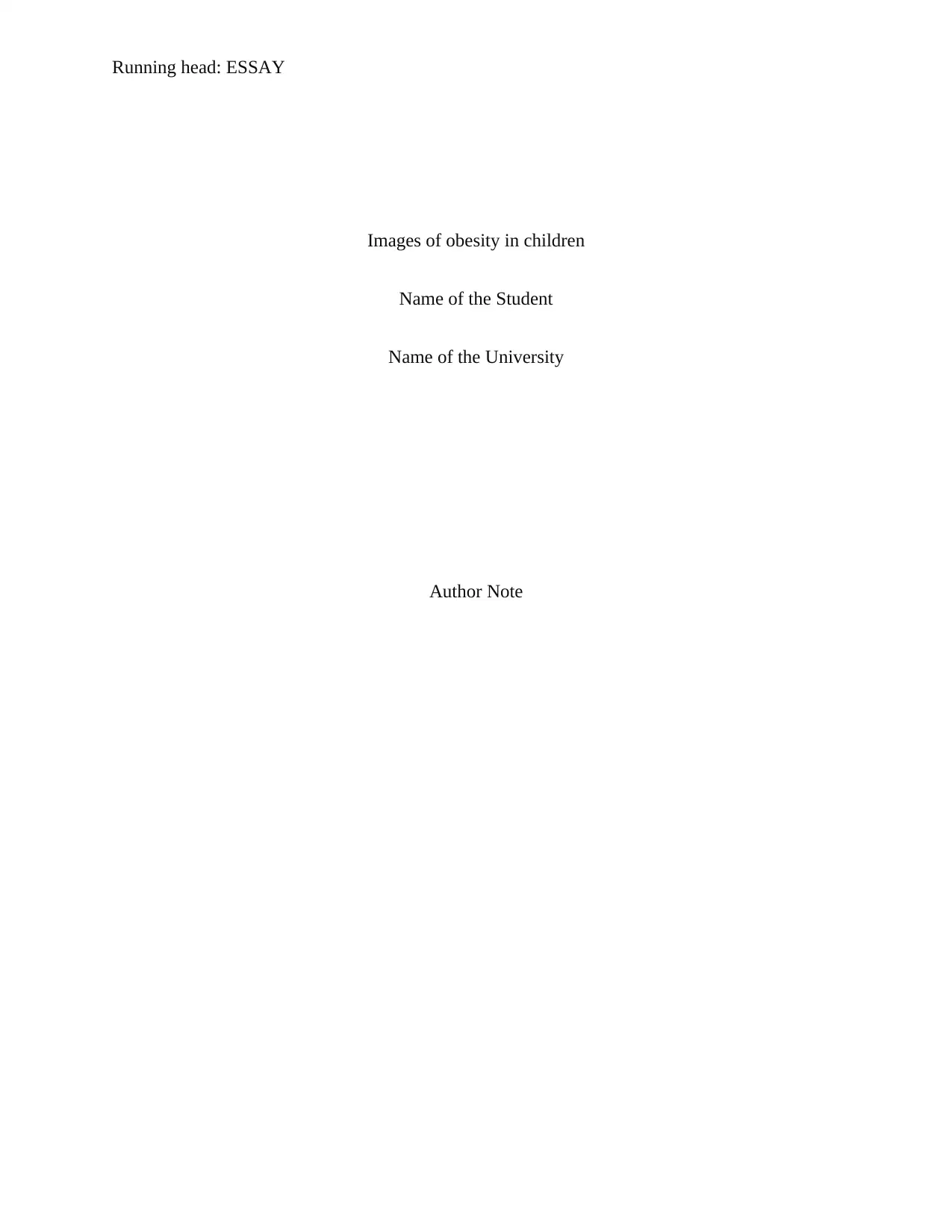
Running head: ESSAY
Images of obesity in children
Name of the Student
Name of the University
Author Note
Images of obesity in children
Name of the Student
Name of the University
Author Note
Secure Best Marks with AI Grader
Need help grading? Try our AI Grader for instant feedback on your assignments.
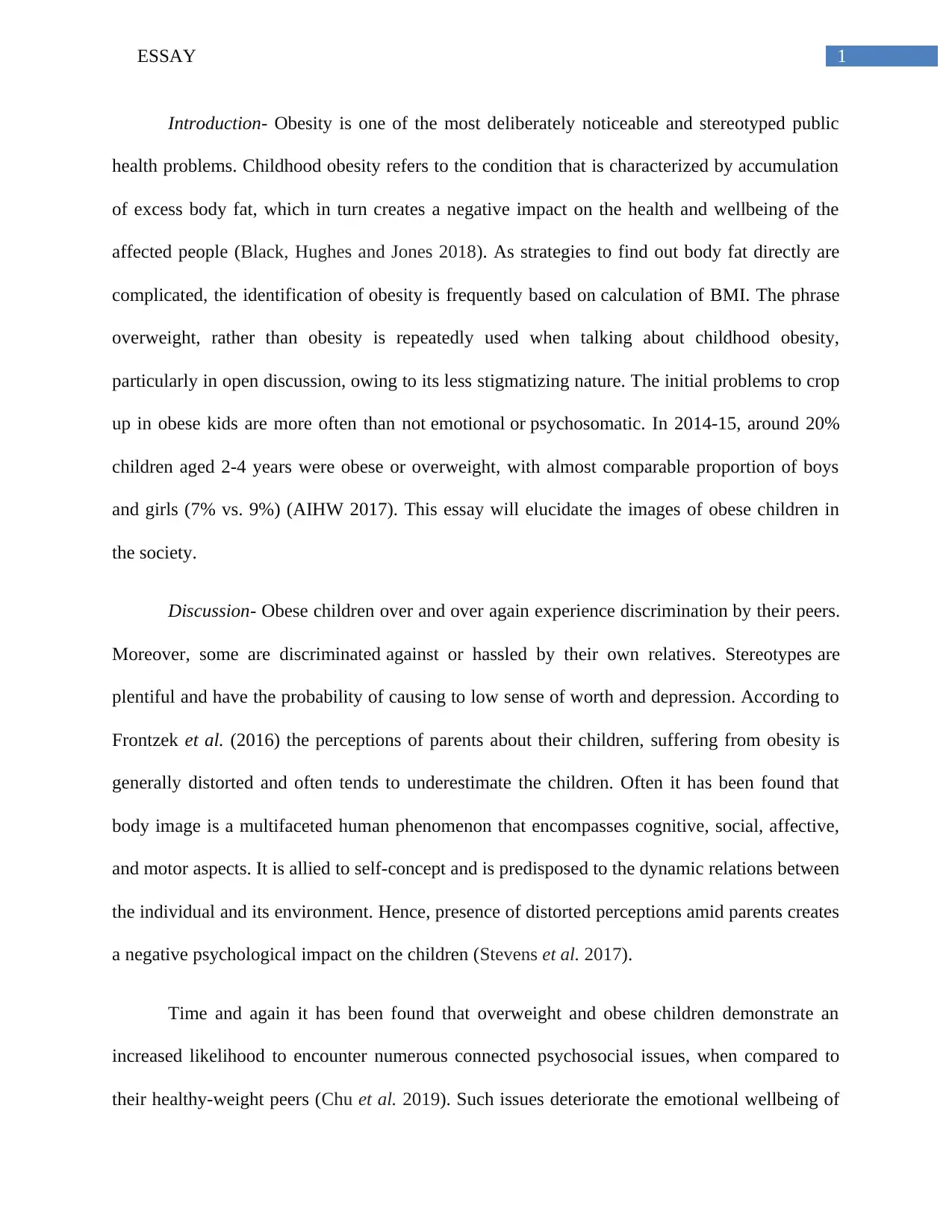
1ESSAY
Introduction- Obesity is one of the most deliberately noticeable and stereotyped public
health problems. Childhood obesity refers to the condition that is characterized by accumulation
of excess body fat, which in turn creates a negative impact on the health and wellbeing of the
affected people (Black, Hughes and Jones 2018). As strategies to find out body fat directly are
complicated, the identification of obesity is frequently based on calculation of BMI. The phrase
overweight, rather than obesity is repeatedly used when talking about childhood obesity,
particularly in open discussion, owing to its less stigmatizing nature. The initial problems to crop
up in obese kids are more often than not emotional or psychosomatic. In 2014-15, around 20%
children aged 2-4 years were obese or overweight, with almost comparable proportion of boys
and girls (7% vs. 9%) (AIHW 2017). This essay will elucidate the images of obese children in
the society.
Discussion- Obese children over and over again experience discrimination by their peers.
Moreover, some are discriminated against or hassled by their own relatives. Stereotypes are
plentiful and have the probability of causing to low sense of worth and depression. According to
Frontzek et al. (2016) the perceptions of parents about their children, suffering from obesity is
generally distorted and often tends to underestimate the children. Often it has been found that
body image is a multifaceted human phenomenon that encompasses cognitive, social, affective,
and motor aspects. It is allied to self-concept and is predisposed to the dynamic relations between
the individual and its environment. Hence, presence of distorted perceptions amid parents creates
a negative psychological impact on the children (Stevens et al. 2017).
Time and again it has been found that overweight and obese children demonstrate an
increased likelihood to encounter numerous connected psychosocial issues, when compared to
their healthy-weight peers (Chu et al. 2019). Such issues deteriorate the emotional wellbeing of
Introduction- Obesity is one of the most deliberately noticeable and stereotyped public
health problems. Childhood obesity refers to the condition that is characterized by accumulation
of excess body fat, which in turn creates a negative impact on the health and wellbeing of the
affected people (Black, Hughes and Jones 2018). As strategies to find out body fat directly are
complicated, the identification of obesity is frequently based on calculation of BMI. The phrase
overweight, rather than obesity is repeatedly used when talking about childhood obesity,
particularly in open discussion, owing to its less stigmatizing nature. The initial problems to crop
up in obese kids are more often than not emotional or psychosomatic. In 2014-15, around 20%
children aged 2-4 years were obese or overweight, with almost comparable proportion of boys
and girls (7% vs. 9%) (AIHW 2017). This essay will elucidate the images of obese children in
the society.
Discussion- Obese children over and over again experience discrimination by their peers.
Moreover, some are discriminated against or hassled by their own relatives. Stereotypes are
plentiful and have the probability of causing to low sense of worth and depression. According to
Frontzek et al. (2016) the perceptions of parents about their children, suffering from obesity is
generally distorted and often tends to underestimate the children. Often it has been found that
body image is a multifaceted human phenomenon that encompasses cognitive, social, affective,
and motor aspects. It is allied to self-concept and is predisposed to the dynamic relations between
the individual and its environment. Hence, presence of distorted perceptions amid parents creates
a negative psychological impact on the children (Stevens et al. 2017).
Time and again it has been found that overweight and obese children demonstrate an
increased likelihood to encounter numerous connected psychosocial issues, when compared to
their healthy-weight peers (Chu et al. 2019). Such issues deteriorate the emotional wellbeing of
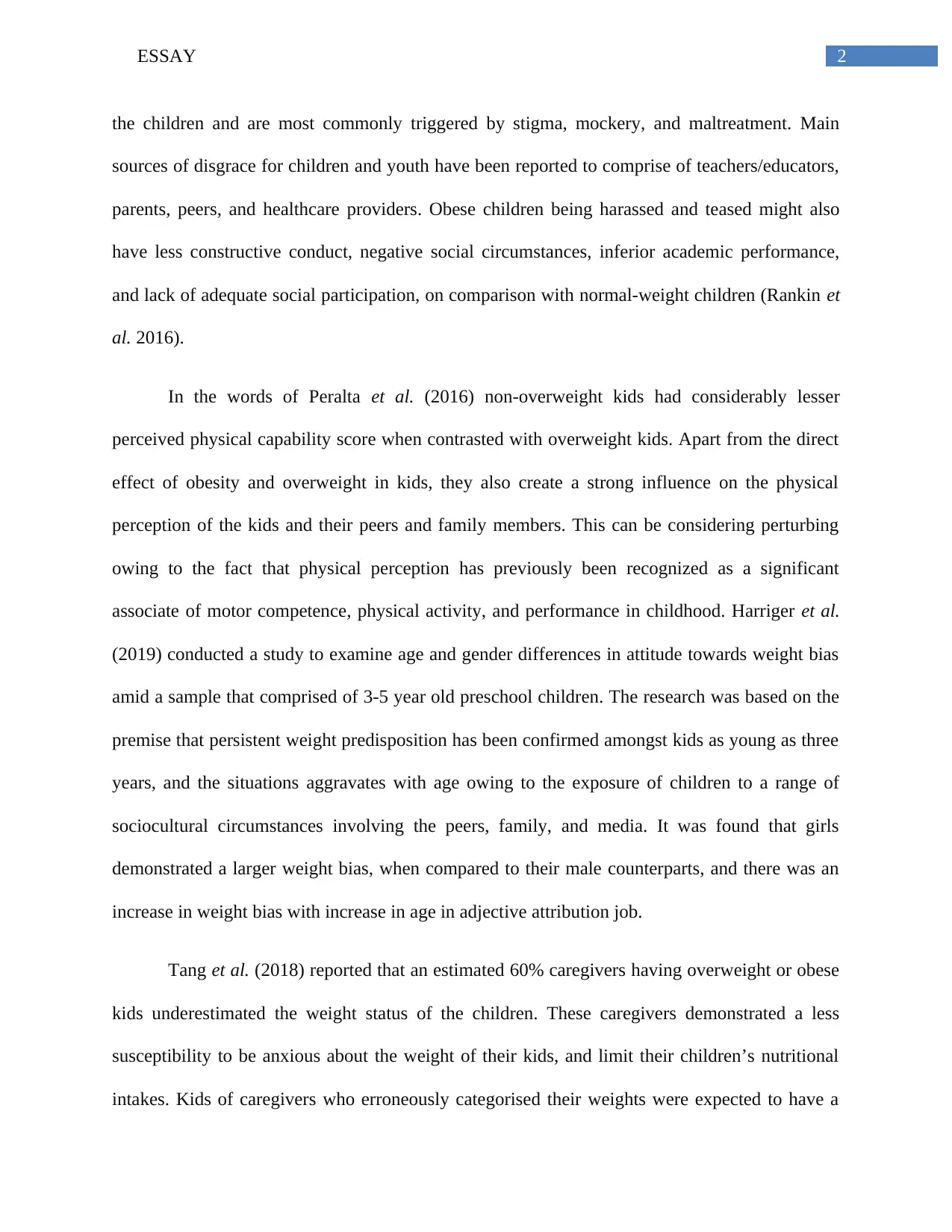
2ESSAY
the children and are most commonly triggered by stigma, mockery, and maltreatment. Main
sources of disgrace for children and youth have been reported to comprise of teachers/educators,
parents, peers, and healthcare providers. Obese children being harassed and teased might also
have less constructive conduct, negative social circumstances, inferior academic performance,
and lack of adequate social participation, on comparison with normal-weight children (Rankin et
al. 2016).
In the words of Peralta et al. (2016) non-overweight kids had considerably lesser
perceived physical capability score when contrasted with overweight kids. Apart from the direct
effect of obesity and overweight in kids, they also create a strong influence on the physical
perception of the kids and their peers and family members. This can be considering perturbing
owing to the fact that physical perception has previously been recognized as a significant
associate of motor competence, physical activity, and performance in childhood. Harriger et al.
(2019) conducted a study to examine age and gender differences in attitude towards weight bias
amid a sample that comprised of 3-5 year old preschool children. The research was based on the
premise that persistent weight predisposition has been confirmed amongst kids as young as three
years, and the situations aggravates with age owing to the exposure of children to a range of
sociocultural circumstances involving the peers, family, and media. It was found that girls
demonstrated a larger weight bias, when compared to their male counterparts, and there was an
increase in weight bias with increase in age in adjective attribution job.
Tang et al. (2018) reported that an estimated 60% caregivers having overweight or obese
kids underestimated the weight status of the children. These caregivers demonstrated a less
susceptibility to be anxious about the weight of their kids, and limit their children’s nutritional
intakes. Kids of caregivers who erroneously categorised their weights were expected to have a
the children and are most commonly triggered by stigma, mockery, and maltreatment. Main
sources of disgrace for children and youth have been reported to comprise of teachers/educators,
parents, peers, and healthcare providers. Obese children being harassed and teased might also
have less constructive conduct, negative social circumstances, inferior academic performance,
and lack of adequate social participation, on comparison with normal-weight children (Rankin et
al. 2016).
In the words of Peralta et al. (2016) non-overweight kids had considerably lesser
perceived physical capability score when contrasted with overweight kids. Apart from the direct
effect of obesity and overweight in kids, they also create a strong influence on the physical
perception of the kids and their peers and family members. This can be considering perturbing
owing to the fact that physical perception has previously been recognized as a significant
associate of motor competence, physical activity, and performance in childhood. Harriger et al.
(2019) conducted a study to examine age and gender differences in attitude towards weight bias
amid a sample that comprised of 3-5 year old preschool children. The research was based on the
premise that persistent weight predisposition has been confirmed amongst kids as young as three
years, and the situations aggravates with age owing to the exposure of children to a range of
sociocultural circumstances involving the peers, family, and media. It was found that girls
demonstrated a larger weight bias, when compared to their male counterparts, and there was an
increase in weight bias with increase in age in adjective attribution job.
Tang et al. (2018) reported that an estimated 60% caregivers having overweight or obese
kids underestimated the weight status of the children. These caregivers demonstrated a less
susceptibility to be anxious about the weight of their kids, and limit their children’s nutritional
intakes. Kids of caregivers who erroneously categorised their weights were expected to have a
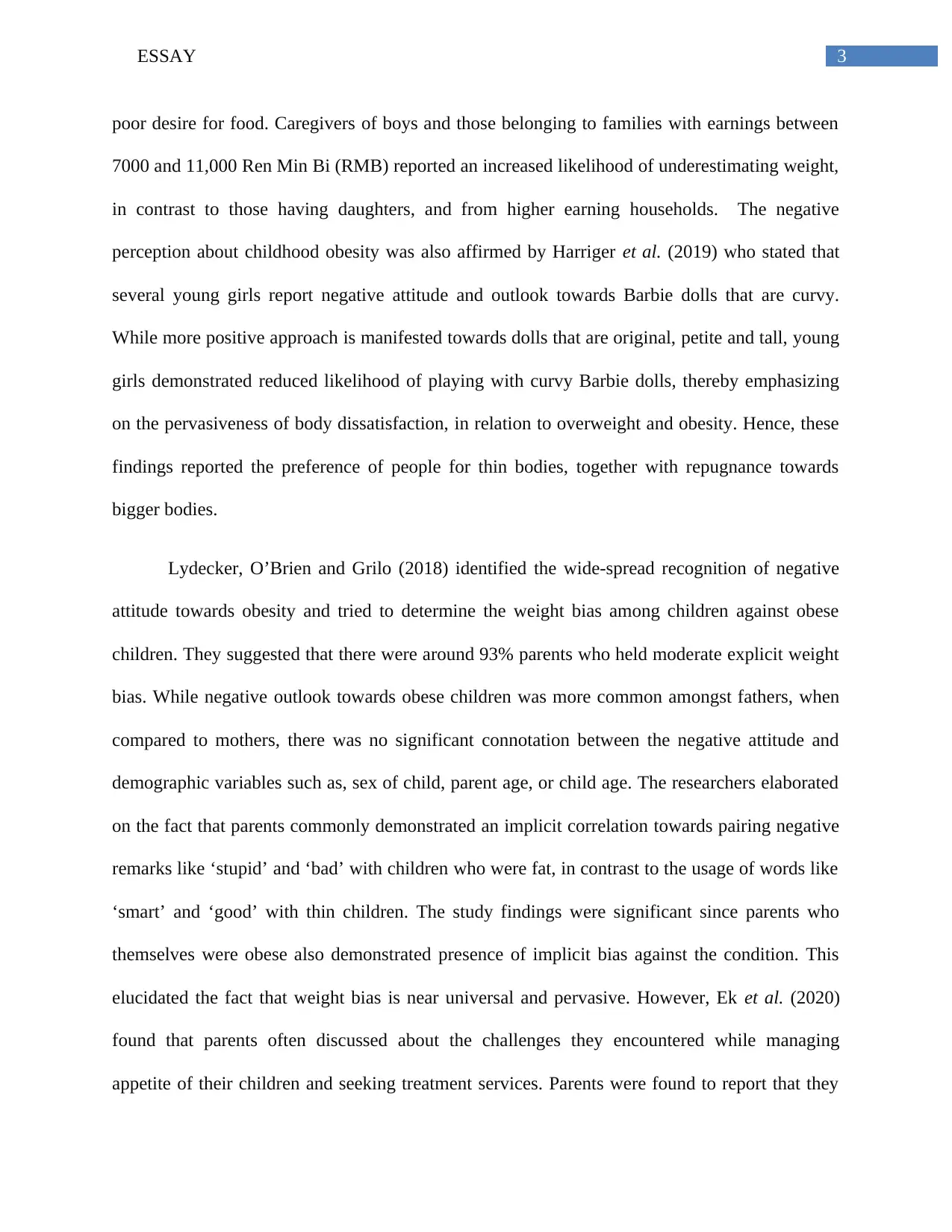
3ESSAY
poor desire for food. Caregivers of boys and those belonging to families with earnings between
7000 and 11,000 Ren Min Bi (RMB) reported an increased likelihood of underestimating weight,
in contrast to those having daughters, and from higher earning households. The negative
perception about childhood obesity was also affirmed by Harriger et al. (2019) who stated that
several young girls report negative attitude and outlook towards Barbie dolls that are curvy.
While more positive approach is manifested towards dolls that are original, petite and tall, young
girls demonstrated reduced likelihood of playing with curvy Barbie dolls, thereby emphasizing
on the pervasiveness of body dissatisfaction, in relation to overweight and obesity. Hence, these
findings reported the preference of people for thin bodies, together with repugnance towards
bigger bodies.
Lydecker, O’Brien and Grilo (2018) identified the wide-spread recognition of negative
attitude towards obesity and tried to determine the weight bias among children against obese
children. They suggested that there were around 93% parents who held moderate explicit weight
bias. While negative outlook towards obese children was more common amongst fathers, when
compared to mothers, there was no significant connotation between the negative attitude and
demographic variables such as, sex of child, parent age, or child age. The researchers elaborated
on the fact that parents commonly demonstrated an implicit correlation towards pairing negative
remarks like ‘stupid’ and ‘bad’ with children who were fat, in contrast to the usage of words like
‘smart’ and ‘good’ with thin children. The study findings were significant since parents who
themselves were obese also demonstrated presence of implicit bias against the condition. This
elucidated the fact that weight bias is near universal and pervasive. However, Ek et al. (2020)
found that parents often discussed about the challenges they encountered while managing
appetite of their children and seeking treatment services. Parents were found to report that they
poor desire for food. Caregivers of boys and those belonging to families with earnings between
7000 and 11,000 Ren Min Bi (RMB) reported an increased likelihood of underestimating weight,
in contrast to those having daughters, and from higher earning households. The negative
perception about childhood obesity was also affirmed by Harriger et al. (2019) who stated that
several young girls report negative attitude and outlook towards Barbie dolls that are curvy.
While more positive approach is manifested towards dolls that are original, petite and tall, young
girls demonstrated reduced likelihood of playing with curvy Barbie dolls, thereby emphasizing
on the pervasiveness of body dissatisfaction, in relation to overweight and obesity. Hence, these
findings reported the preference of people for thin bodies, together with repugnance towards
bigger bodies.
Lydecker, O’Brien and Grilo (2018) identified the wide-spread recognition of negative
attitude towards obesity and tried to determine the weight bias among children against obese
children. They suggested that there were around 93% parents who held moderate explicit weight
bias. While negative outlook towards obese children was more common amongst fathers, when
compared to mothers, there was no significant connotation between the negative attitude and
demographic variables such as, sex of child, parent age, or child age. The researchers elaborated
on the fact that parents commonly demonstrated an implicit correlation towards pairing negative
remarks like ‘stupid’ and ‘bad’ with children who were fat, in contrast to the usage of words like
‘smart’ and ‘good’ with thin children. The study findings were significant since parents who
themselves were obese also demonstrated presence of implicit bias against the condition. This
elucidated the fact that weight bias is near universal and pervasive. However, Ek et al. (2020)
found that parents often discussed about the challenges they encountered while managing
appetite of their children and seeking treatment services. Parents were found to report that they
Secure Best Marks with AI Grader
Need help grading? Try our AI Grader for instant feedback on your assignments.
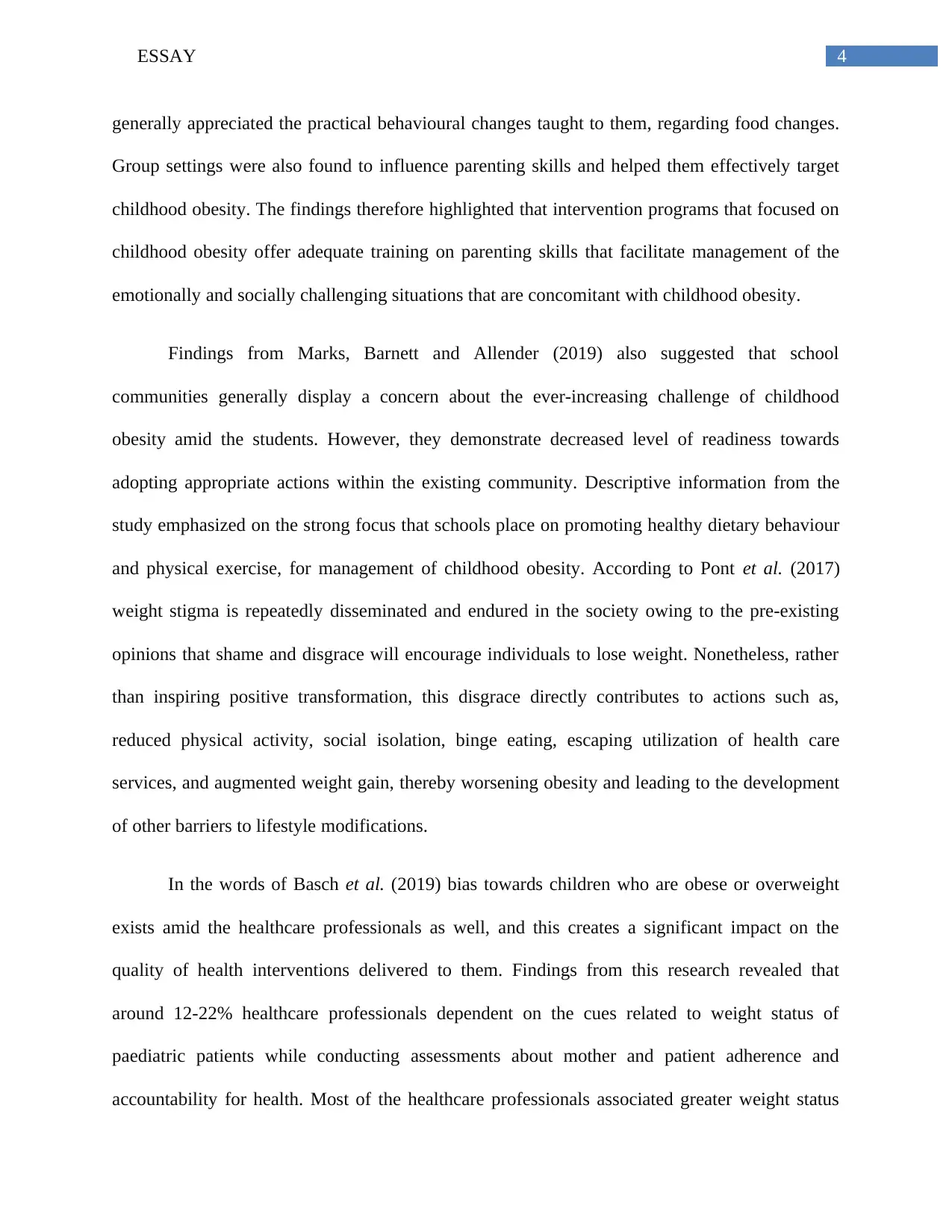
4ESSAY
generally appreciated the practical behavioural changes taught to them, regarding food changes.
Group settings were also found to influence parenting skills and helped them effectively target
childhood obesity. The findings therefore highlighted that intervention programs that focused on
childhood obesity offer adequate training on parenting skills that facilitate management of the
emotionally and socially challenging situations that are concomitant with childhood obesity.
Findings from Marks, Barnett and Allender (2019) also suggested that school
communities generally display a concern about the ever-increasing challenge of childhood
obesity amid the students. However, they demonstrate decreased level of readiness towards
adopting appropriate actions within the existing community. Descriptive information from the
study emphasized on the strong focus that schools place on promoting healthy dietary behaviour
and physical exercise, for management of childhood obesity. According to Pont et al. (2017)
weight stigma is repeatedly disseminated and endured in the society owing to the pre-existing
opinions that shame and disgrace will encourage individuals to lose weight. Nonetheless, rather
than inspiring positive transformation, this disgrace directly contributes to actions such as,
reduced physical activity, social isolation, binge eating, escaping utilization of health care
services, and augmented weight gain, thereby worsening obesity and leading to the development
of other barriers to lifestyle modifications.
In the words of Basch et al. (2019) bias towards children who are obese or overweight
exists amid the healthcare professionals as well, and this creates a significant impact on the
quality of health interventions delivered to them. Findings from this research revealed that
around 12-22% healthcare professionals dependent on the cues related to weight status of
paediatric patients while conducting assessments about mother and patient adherence and
accountability for health. Most of the healthcare professionals associated greater weight status
generally appreciated the practical behavioural changes taught to them, regarding food changes.
Group settings were also found to influence parenting skills and helped them effectively target
childhood obesity. The findings therefore highlighted that intervention programs that focused on
childhood obesity offer adequate training on parenting skills that facilitate management of the
emotionally and socially challenging situations that are concomitant with childhood obesity.
Findings from Marks, Barnett and Allender (2019) also suggested that school
communities generally display a concern about the ever-increasing challenge of childhood
obesity amid the students. However, they demonstrate decreased level of readiness towards
adopting appropriate actions within the existing community. Descriptive information from the
study emphasized on the strong focus that schools place on promoting healthy dietary behaviour
and physical exercise, for management of childhood obesity. According to Pont et al. (2017)
weight stigma is repeatedly disseminated and endured in the society owing to the pre-existing
opinions that shame and disgrace will encourage individuals to lose weight. Nonetheless, rather
than inspiring positive transformation, this disgrace directly contributes to actions such as,
reduced physical activity, social isolation, binge eating, escaping utilization of health care
services, and augmented weight gain, thereby worsening obesity and leading to the development
of other barriers to lifestyle modifications.
In the words of Basch et al. (2019) bias towards children who are obese or overweight
exists amid the healthcare professionals as well, and this creates a significant impact on the
quality of health interventions delivered to them. Findings from this research revealed that
around 12-22% healthcare professionals dependent on the cues related to weight status of
paediatric patients while conducting assessments about mother and patient adherence and
accountability for health. Most of the healthcare professionals associated greater weight status
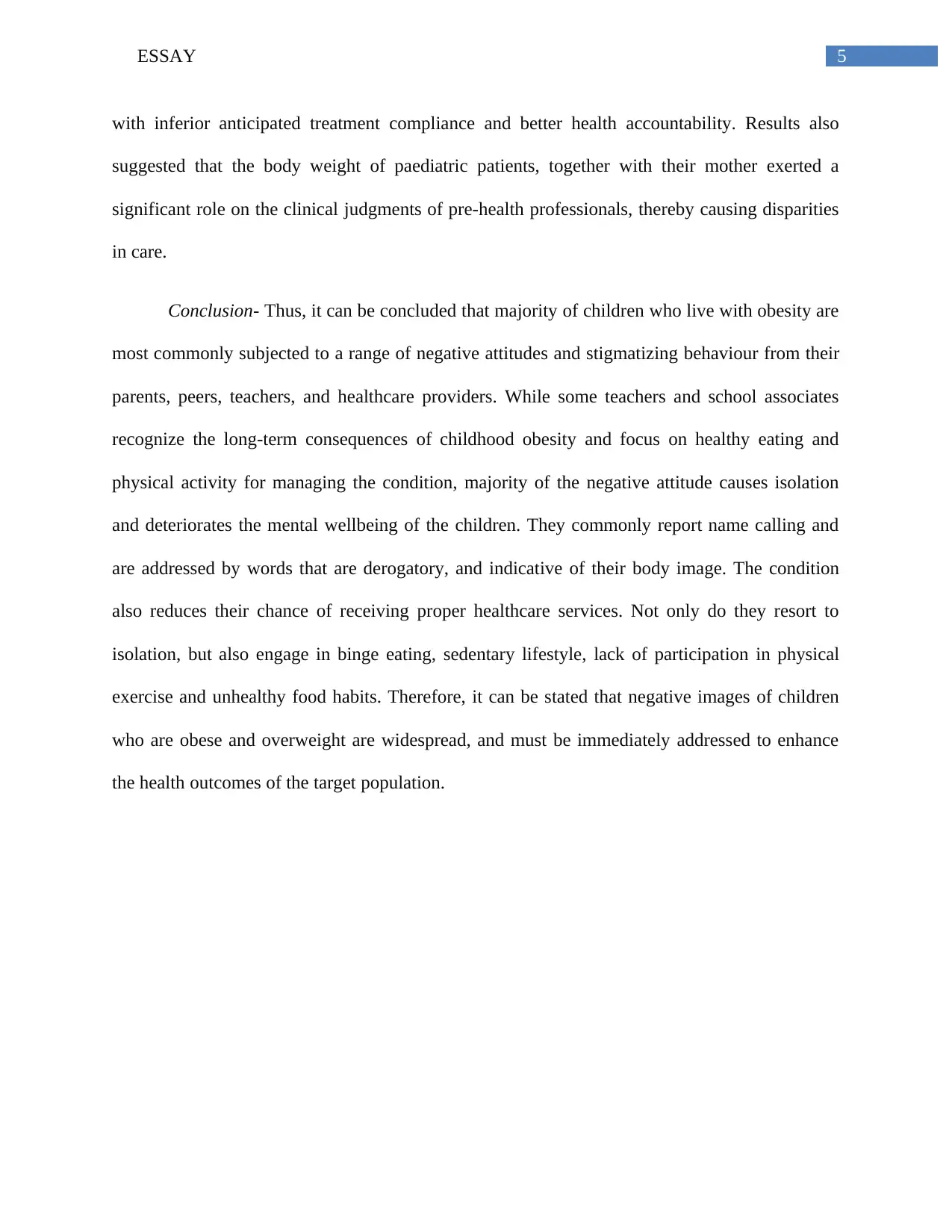
5ESSAY
with inferior anticipated treatment compliance and better health accountability. Results also
suggested that the body weight of paediatric patients, together with their mother exerted a
significant role on the clinical judgments of pre-health professionals, thereby causing disparities
in care.
Conclusion- Thus, it can be concluded that majority of children who live with obesity are
most commonly subjected to a range of negative attitudes and stigmatizing behaviour from their
parents, peers, teachers, and healthcare providers. While some teachers and school associates
recognize the long-term consequences of childhood obesity and focus on healthy eating and
physical activity for managing the condition, majority of the negative attitude causes isolation
and deteriorates the mental wellbeing of the children. They commonly report name calling and
are addressed by words that are derogatory, and indicative of their body image. The condition
also reduces their chance of receiving proper healthcare services. Not only do they resort to
isolation, but also engage in binge eating, sedentary lifestyle, lack of participation in physical
exercise and unhealthy food habits. Therefore, it can be stated that negative images of children
who are obese and overweight are widespread, and must be immediately addressed to enhance
the health outcomes of the target population.
with inferior anticipated treatment compliance and better health accountability. Results also
suggested that the body weight of paediatric patients, together with their mother exerted a
significant role on the clinical judgments of pre-health professionals, thereby causing disparities
in care.
Conclusion- Thus, it can be concluded that majority of children who live with obesity are
most commonly subjected to a range of negative attitudes and stigmatizing behaviour from their
parents, peers, teachers, and healthcare providers. While some teachers and school associates
recognize the long-term consequences of childhood obesity and focus on healthy eating and
physical activity for managing the condition, majority of the negative attitude causes isolation
and deteriorates the mental wellbeing of the children. They commonly report name calling and
are addressed by words that are derogatory, and indicative of their body image. The condition
also reduces their chance of receiving proper healthcare services. Not only do they resort to
isolation, but also engage in binge eating, sedentary lifestyle, lack of participation in physical
exercise and unhealthy food habits. Therefore, it can be stated that negative images of children
who are obese and overweight are widespread, and must be immediately addressed to enhance
the health outcomes of the target population.
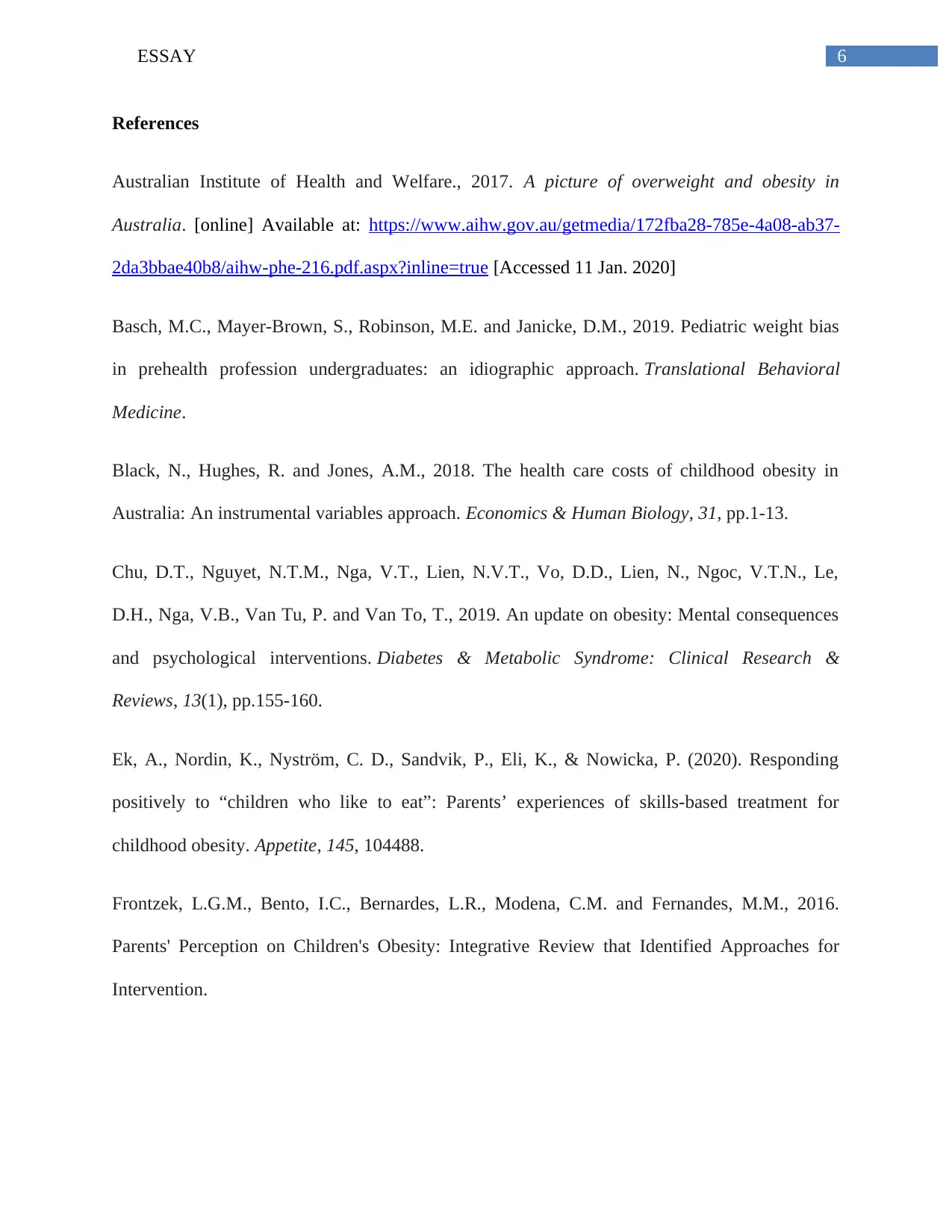
6ESSAY
References
Australian Institute of Health and Welfare., 2017. A picture of overweight and obesity in
Australia. [online] Available at: https://www.aihw.gov.au/getmedia/172fba28-785e-4a08-ab37-
2da3bbae40b8/aihw-phe-216.pdf.aspx?inline=true [Accessed 11 Jan. 2020]
Basch, M.C., Mayer-Brown, S., Robinson, M.E. and Janicke, D.M., 2019. Pediatric weight bias
in prehealth profession undergraduates: an idiographic approach. Translational Behavioral
Medicine.
Black, N., Hughes, R. and Jones, A.M., 2018. The health care costs of childhood obesity in
Australia: An instrumental variables approach. Economics & Human Biology, 31, pp.1-13.
Chu, D.T., Nguyet, N.T.M., Nga, V.T., Lien, N.V.T., Vo, D.D., Lien, N., Ngoc, V.T.N., Le,
D.H., Nga, V.B., Van Tu, P. and Van To, T., 2019. An update on obesity: Mental consequences
and psychological interventions. Diabetes & Metabolic Syndrome: Clinical Research &
Reviews, 13(1), pp.155-160.
Ek, A., Nordin, K., Nyström, C. D., Sandvik, P., Eli, K., & Nowicka, P. (2020). Responding
positively to “children who like to eat”: Parents’ experiences of skills-based treatment for
childhood obesity. Appetite, 145, 104488.
Frontzek, L.G.M., Bento, I.C., Bernardes, L.R., Modena, C.M. and Fernandes, M.M., 2016.
Parents' Perception on Children's Obesity: Integrative Review that Identified Approaches for
Intervention.
References
Australian Institute of Health and Welfare., 2017. A picture of overweight and obesity in
Australia. [online] Available at: https://www.aihw.gov.au/getmedia/172fba28-785e-4a08-ab37-
2da3bbae40b8/aihw-phe-216.pdf.aspx?inline=true [Accessed 11 Jan. 2020]
Basch, M.C., Mayer-Brown, S., Robinson, M.E. and Janicke, D.M., 2019. Pediatric weight bias
in prehealth profession undergraduates: an idiographic approach. Translational Behavioral
Medicine.
Black, N., Hughes, R. and Jones, A.M., 2018. The health care costs of childhood obesity in
Australia: An instrumental variables approach. Economics & Human Biology, 31, pp.1-13.
Chu, D.T., Nguyet, N.T.M., Nga, V.T., Lien, N.V.T., Vo, D.D., Lien, N., Ngoc, V.T.N., Le,
D.H., Nga, V.B., Van Tu, P. and Van To, T., 2019. An update on obesity: Mental consequences
and psychological interventions. Diabetes & Metabolic Syndrome: Clinical Research &
Reviews, 13(1), pp.155-160.
Ek, A., Nordin, K., Nyström, C. D., Sandvik, P., Eli, K., & Nowicka, P. (2020). Responding
positively to “children who like to eat”: Parents’ experiences of skills-based treatment for
childhood obesity. Appetite, 145, 104488.
Frontzek, L.G.M., Bento, I.C., Bernardes, L.R., Modena, C.M. and Fernandes, M.M., 2016.
Parents' Perception on Children's Obesity: Integrative Review that Identified Approaches for
Intervention.
Paraphrase This Document
Need a fresh take? Get an instant paraphrase of this document with our AI Paraphraser
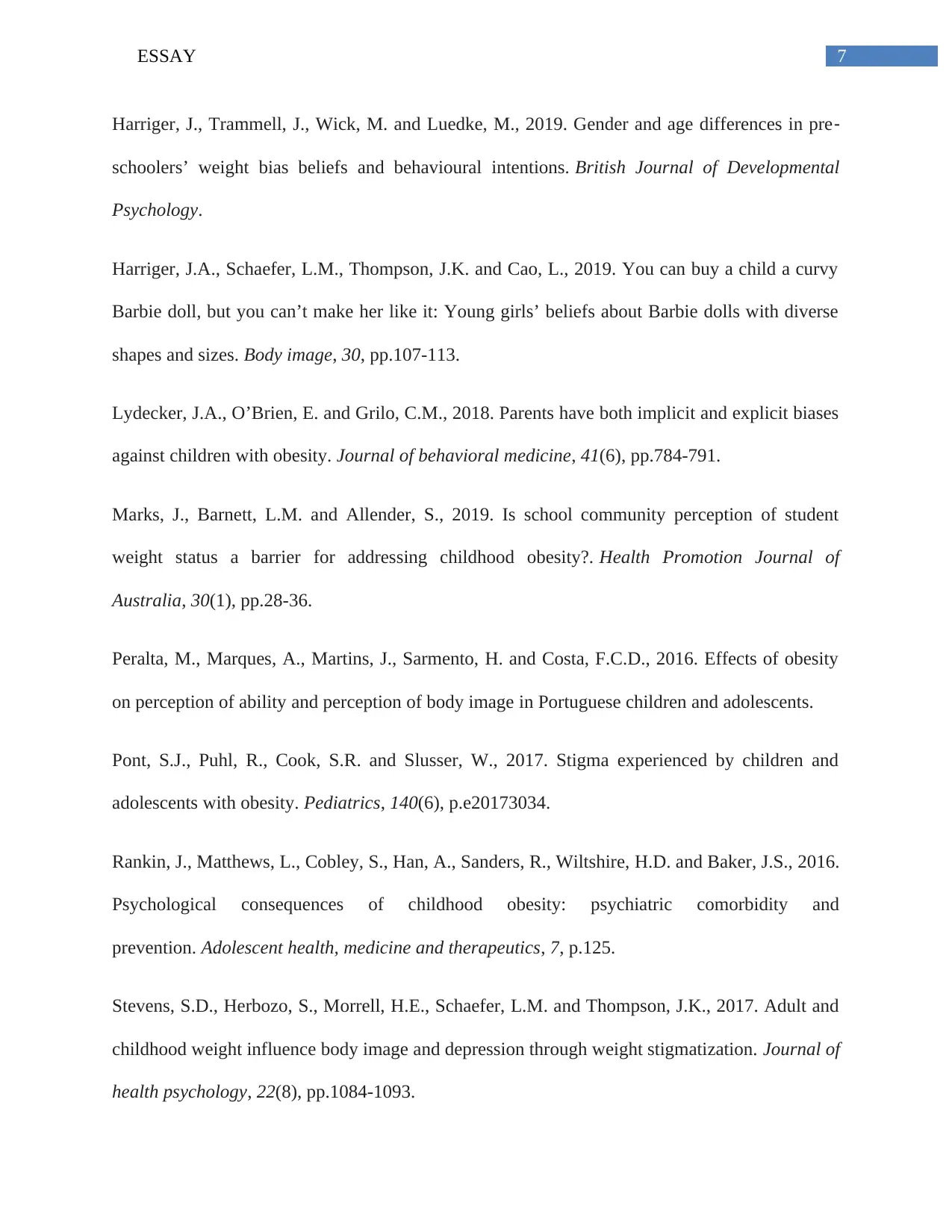
7ESSAY
Harriger, J., Trammell, J., Wick, M. and Luedke, M., 2019. Gender and age differences in pre‐
schoolers’ weight bias beliefs and behavioural intentions. British Journal of Developmental
Psychology.
Harriger, J.A., Schaefer, L.M., Thompson, J.K. and Cao, L., 2019. You can buy a child a curvy
Barbie doll, but you can’t make her like it: Young girls’ beliefs about Barbie dolls with diverse
shapes and sizes. Body image, 30, pp.107-113.
Lydecker, J.A., O’Brien, E. and Grilo, C.M., 2018. Parents have both implicit and explicit biases
against children with obesity. Journal of behavioral medicine, 41(6), pp.784-791.
Marks, J., Barnett, L.M. and Allender, S., 2019. Is school community perception of student
weight status a barrier for addressing childhood obesity?. Health Promotion Journal of
Australia, 30(1), pp.28-36.
Peralta, M., Marques, A., Martins, J., Sarmento, H. and Costa, F.C.D., 2016. Effects of obesity
on perception of ability and perception of body image in Portuguese children and adolescents.
Pont, S.J., Puhl, R., Cook, S.R. and Slusser, W., 2017. Stigma experienced by children and
adolescents with obesity. Pediatrics, 140(6), p.e20173034.
Rankin, J., Matthews, L., Cobley, S., Han, A., Sanders, R., Wiltshire, H.D. and Baker, J.S., 2016.
Psychological consequences of childhood obesity: psychiatric comorbidity and
prevention. Adolescent health, medicine and therapeutics, 7, p.125.
Stevens, S.D., Herbozo, S., Morrell, H.E., Schaefer, L.M. and Thompson, J.K., 2017. Adult and
childhood weight influence body image and depression through weight stigmatization. Journal of
health psychology, 22(8), pp.1084-1093.
Harriger, J., Trammell, J., Wick, M. and Luedke, M., 2019. Gender and age differences in pre‐
schoolers’ weight bias beliefs and behavioural intentions. British Journal of Developmental
Psychology.
Harriger, J.A., Schaefer, L.M., Thompson, J.K. and Cao, L., 2019. You can buy a child a curvy
Barbie doll, but you can’t make her like it: Young girls’ beliefs about Barbie dolls with diverse
shapes and sizes. Body image, 30, pp.107-113.
Lydecker, J.A., O’Brien, E. and Grilo, C.M., 2018. Parents have both implicit and explicit biases
against children with obesity. Journal of behavioral medicine, 41(6), pp.784-791.
Marks, J., Barnett, L.M. and Allender, S., 2019. Is school community perception of student
weight status a barrier for addressing childhood obesity?. Health Promotion Journal of
Australia, 30(1), pp.28-36.
Peralta, M., Marques, A., Martins, J., Sarmento, H. and Costa, F.C.D., 2016. Effects of obesity
on perception of ability and perception of body image in Portuguese children and adolescents.
Pont, S.J., Puhl, R., Cook, S.R. and Slusser, W., 2017. Stigma experienced by children and
adolescents with obesity. Pediatrics, 140(6), p.e20173034.
Rankin, J., Matthews, L., Cobley, S., Han, A., Sanders, R., Wiltshire, H.D. and Baker, J.S., 2016.
Psychological consequences of childhood obesity: psychiatric comorbidity and
prevention. Adolescent health, medicine and therapeutics, 7, p.125.
Stevens, S.D., Herbozo, S., Morrell, H.E., Schaefer, L.M. and Thompson, J.K., 2017. Adult and
childhood weight influence body image and depression through weight stigmatization. Journal of
health psychology, 22(8), pp.1084-1093.
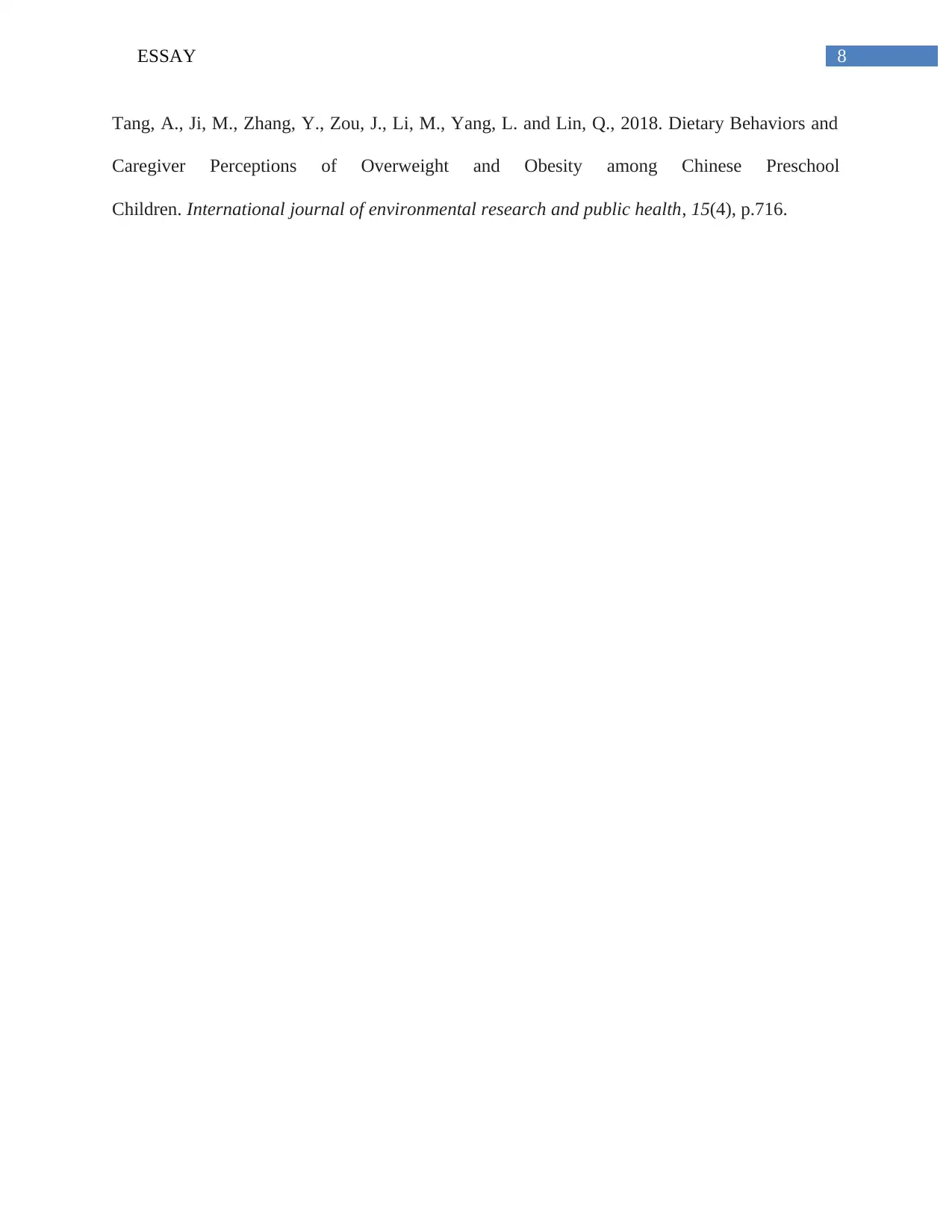
8ESSAY
Tang, A., Ji, M., Zhang, Y., Zou, J., Li, M., Yang, L. and Lin, Q., 2018. Dietary Behaviors and
Caregiver Perceptions of Overweight and Obesity among Chinese Preschool
Children. International journal of environmental research and public health, 15(4), p.716.
Tang, A., Ji, M., Zhang, Y., Zou, J., Li, M., Yang, L. and Lin, Q., 2018. Dietary Behaviors and
Caregiver Perceptions of Overweight and Obesity among Chinese Preschool
Children. International journal of environmental research and public health, 15(4), p.716.
1 out of 9
Related Documents
Your All-in-One AI-Powered Toolkit for Academic Success.
+13062052269
info@desklib.com
Available 24*7 on WhatsApp / Email
![[object Object]](/_next/static/media/star-bottom.7253800d.svg)
Unlock your academic potential
© 2024 | Zucol Services PVT LTD | All rights reserved.





